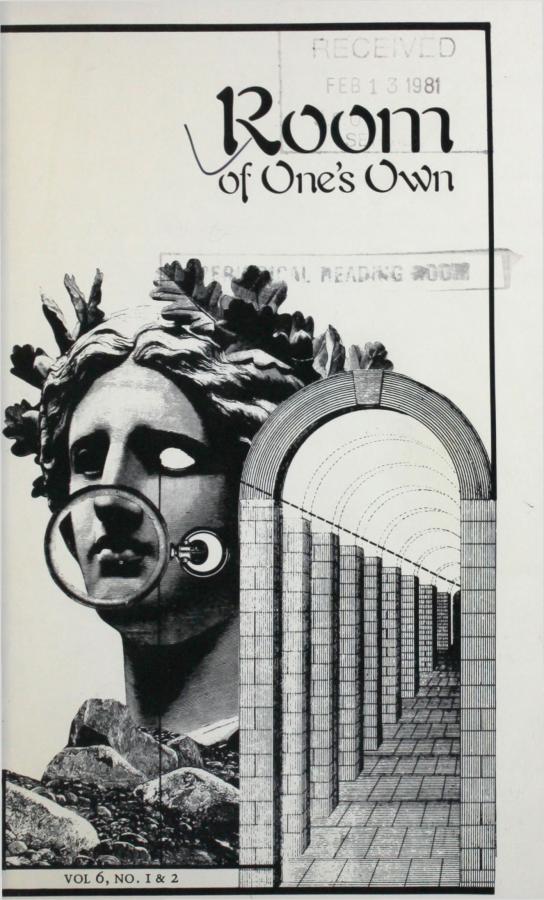ROOM 6.1 & 6.2 Susan Wood
1981
Digital only; out of stock in print.
The title op Marjorie Harris’s sculpture group, “Showing the Wound as a Positive Stage in Transformation,” the frontispiece for this issue, says almost everything about women’s fantasy/ science fiction in 1980. More and more, women are turning to these forms to express our rage at the way we must live our lives, to cleanse our wounds, and, most important, to express our dreams of a better future, another world, where equality, sisterhood, and above all, love, are possible.
Manuscripts for this issue came in at the rate of three a day, reflecting the strong new role of women in the professional sf/ fantasy field, in the sf “fan” community, and in literature in general. Suddenly, many women have found their voices as sf/ fantasy writers, their visions as artists. While this collection was coming together, Jessica Salmonson sold her novel, The Tomoe Cozen Saga, to Ace; Eileen Kernaghan received confirmation of her sale to Ace of the novel tentatively called Journey to Aprilioth; Jessica Salmonson and Wendy Schultz were asked to give their slide presentation/lecture about women warriors on a national tour, all expenses paid; Jeanne Gomoll, Joan Hanke-Woods, and Victoria Poyser were all nominated for sf’s top honour, the Hugo Award, as Best Fan Artist; Janus was nominated for “Best Fanzine” ; and I was nominated for the Best Non-Fiction Hugo, forediting The Language of the Night: Essays on Fantasy and Science Fiction by Ursula K. LeGuin.
If I had known how much joy editing this collection would bring me, despite the work involved, I’d have taken on the task sooner. You’ve made me laugh; you’ve moved me, often, to tears. You’ve sent me lovely letters; yes, Maggie, the project is “fun, friends, and family.” You have left me—Gerry-Anne and Debbie especially—with little to add to your words. This is as it should be. An editor’s job is to edit: to find, encourage, and assemble the best material. Included in this collection are photos of some of the women in sf. Look at their smiles. They enjoy what they’re doing. I hope you enjoy their work.
One more point. Science fiction is a modern branch of fantasy, not “ sci-fi.” The term is science fiction, or “ sf,” a convenient abbreviation which can also stand for speculative fiction, speculative fantasy, and, as Jeanne Gomoll pointed out to me, speculative feminism.
Thank you to everyone who contributed and who helped: particularly to Eleanor Wachtel, for her patience; and to Anna Vargo, Lynne Dollis, and Jo McBride, who helped pull it all together. Samantha and Harlequin, the cats, didn’t step on the manuscripts too much. And thank you also to all the women in science fiction.
This issue is dedicated, especially, to Elizabeth A. Lynn, Vonda N. McIntyre, and Marta Randall—good writers and good friends —with admiration and love.
And it is also for my Mum, Elsie Kruge Wood.
—Susan Wood

$10.00
Additional information
| Delivery | Canada, USA, International, Digital |
|---|
In this issue: Eleanor Arnason, Janet Bellwether, Diana Bloom, Elinor Busby, Robin B. Cano, Jayge Carr, Michele Connelly, Terry A. Garey, Jeanne Gomoll, Phyllis Green, Miriam Greenwald, Marjorie Harris, Marilyn Holt, Suzanne Jones, Eileen Kernaghan, Eva-Marie Kröller, Celia S. Lustgarten, Joanne Nelson, Debbie Notkin, Gerry Anne Perlett, Barbara Powis, Victoria Poyser, Jessica Amanda Salmonson, Georgie Schnobrich, Wendy Adrian Shultz, Rose-Marie Tremblay, Lee Waite, Lois Wickstrom, Susan Wood, Joan Hanke Woods